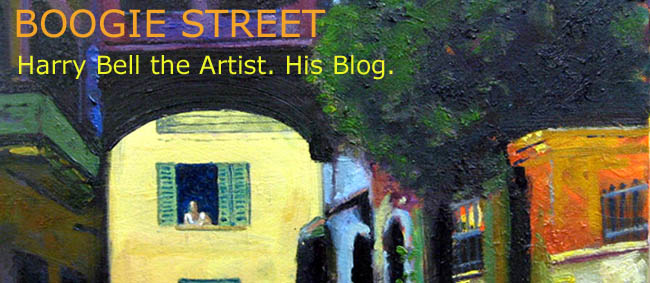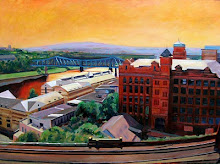Inevitably, I suppose I absorb some influences but they're by no means particularly obvious, and it takes some time to shake off the feeling that something has just ... not happened.
I'm reminded of something Arthur Maderson said in an article in The Artist of March 1990:
The problem often starts by attempting to graft aspects of another painter’s work on to our own, a painter whose character and attitudes may be entirely at odds with ours. Lengthy periods of inactivity are invariably a symptom of this problem.
Not that I think my inactivity is due to this per se, but in looking at other painters' work, I do think there's a tendency to "want to paint like that." The rest of this part of Maderson's article is relevant in this respect, and I try to hold onto it:
Without constructing one’s own individual painterly concerns based firmly on what we are like as a person, then the probability is that the act becomes one of simply copying, in an uncommitted and emotionally neutral manner. A human polaroid approach no less. It is a useful exercise to try looking beyond the surface and begin to understand the ideas and motives behind other people’s paintings, rather than simply ask yourself whether you like it or not.
Van Gogh, for example, was scruffy, bold, impulsive, committed and emotionally unstable. His work clearly reflects these aspects of his personality. Not for him miniature portraits on enamel. On the other hand, we are able to form a strong idea that Vermeer was by disposition intelligent, well-organised, slow, meticulous and sensitive. [.....] Whatever qualities you have, make them work for you. Listen to that small voice in the back of your head which may indicate a yearning for a direction you have not yet dared to explore. It is essential if you are to make what you see your own.
The examples of Van Gogh and Vermeer are good ones, I think, and it can be instructive to consider where one might lie on the line between the two. My own personality is quiet, introspective and considerative. I'm not an especially impulsive person and certainly not given to flamboyancy. Looking at my work, I think those aspects are generally to be seen there. My paintings are carefully composed, not rushed and often dependent on small details for their final impact. On the other hand, I have no interest in photographic realism, where all of the details are included painstakingly and where accuracy is paramount. There are parts of my pictures which are cursory and others where the rendering is quite rough. I think this reflects the disorganised and often haphazard elements of my way of life.
What about you? Can you see yourself in your paintings?
As for the small voice in the back of my head. Well, it is there, and I intend to start listening to it soon.












4 comments:
Flamboyant = strikingly bold or brilliant; showy. Your work could be described by the first, but not the second definition. So maybe you are just a bit flamboyant.
We used to once stay at a house where a wildlife artist worked in the attic; he had fantastic precision, every detail of every feather was perfect. Big canvases or tiny studies, they all shared the same keen eye and careful brushwork. One summer when we were there he started going to a local life class, using pastels - 'to free his arm up'. They were wonderful, big, bold, pretty unsubtle, he said that doing them made him feel wonderful. I have two of these - a dancer and a nude and also one in his other style - a beautiful miniature of a frog. So which is the real him? The big blowsy pastels that he enjoyed so much or his bread an butter animals? Perhaps he could be both, but the small voice sure was calling him to loosen up.
OK, so it's an inexact science. I've done the big, bold drawings, and it's certainly a liberating exercise, but the main body of my work maintains a quality of precision which I find satisfying.
I notice that your friend apparently didn't employ his new-found loosened-up style on pictures of birds. *That* would have been interesting.
As an aside, Tom Wood (see sidebar for link) is currently doing pictures of chickens with quite an attention to detail which was not present in his work of some years ago. What does that mean? I have no idea.
"Lengthy periods of inactivity are invariably a symptom of this problem."
- Ouch!
Sorry to be the bearer of bad tidings, Ian! Of course, you could choose to disbelieve that nice Mr Maderson...
Post a Comment